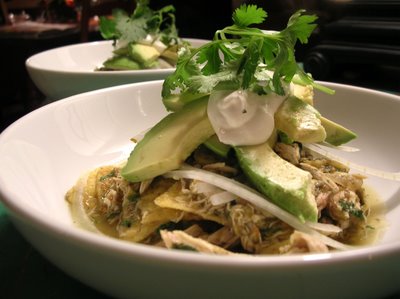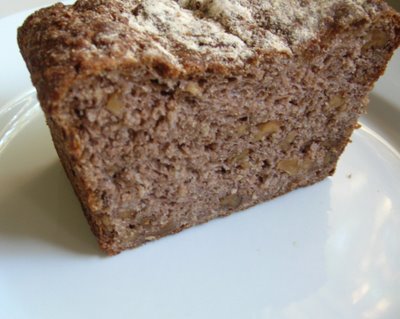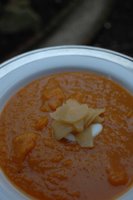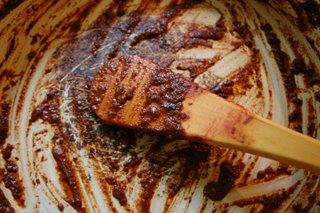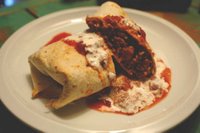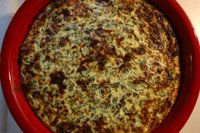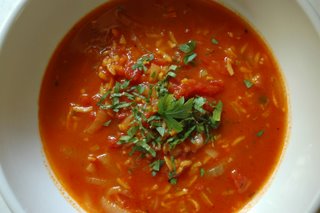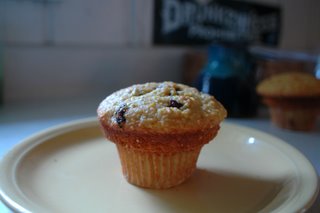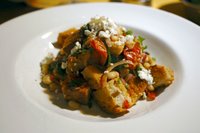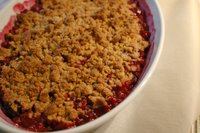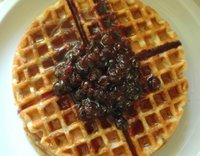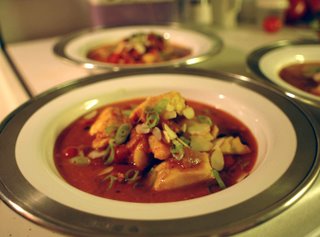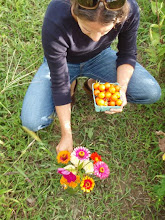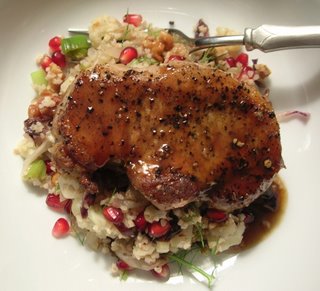
Casa Moro is a book I coveted for a long time before buying a few months ago. I'd read so much about it in the blogging world, that I knew it had to be good. It's a colorful and beautiful book. It's pages are full of the commentary of an English family living in Spain - a couple and their two adorable children. The food is full of robust flavors, but the recipes are all very authentic, and they promise meals that are simple and delicious, like the foods that families serve in their homes all over the Mediteranean.
I took one look at the Winter Tabblouleh recipe and knew it would be the first thing I would make. I'd never really seen a recipe like it, and it looked gorgeous - bulgar, cauliflower, walnuts, pomegranate seeds, mint and parsley - just the sort of dish to lift your spirits in the dark days of winter.
I had some great looking pork chops I wanted to serve with the tabbouleh, and it was a cold night, so instead of creating a raw salad, I decided to cook the vegetables before assembling the salad. I had never used pomegranate molasses before, and was excited at the chance to pull it out of my cupboard, where it's been gathering dust for over a year now. The dressing for the tabbouleh was dead simple - pomegranate molasses, cinnamon, a crushed garlic clove, water, olive oil, salt and pepper. At first taste, I was worried - the molasses tasted like cherry cough syrup to me.... but after letting it sit for awhile, I returned and found that it had transformed into a much more sophisticated version of what I had tasted just 20 minutes before - the sweetness had mellowed and I was intrigued - this was a taste I'd never experienced before.
A last minute decision on my part turned the dressing for the salad into a sauce for the pork; I had browned the chops on the stovetop, then added some stock and popped them in the oven to finish cooking. When they were done, I removed the pan from the oven, set the chops aside, and added the pomegranate dressing to the pork juices and stock in the pan and cooked briefly to make a thick, dark sauce to pour over the pork.
I was pretty excited about how this dish turned out - the sweetness of the pomegranate molasses and the warmth from the cinnamon were a great match for the pork, and the tabbouleh salad was a fun contrast of flavors and textures. It's not often I get make something that I feel is truly different than anything I've made before, but this dish was one of those - it sort of opened my eyes again to the fact that there plenty of foods and combinations out there that I have yet to discover and explore in my own kitchen.
Pomegranate Pork Chops with Winter Tabbouleh
Partially adapted from Casa Moro Cookbook
For the Pork:
2 center cut pork loin chops
1 Tablespoon pomegranate molasses
1 Tablespoon water
1 teaspoon cinnamon
3 Tablespoons extra-virgin olive oil
1 clove garlic, crushed
Salt and pepper
For the Tabbouleh
1 cup coarse bulgar
1 1/2 cup boiling water
1 Tablespoon olive oil
1 cup cauliflower florets, chopped into bite-size pieces
1 small fennel bulb, chopped into bite-size pieces
1 leek, sliced in half lengthwise, then into 1/4-inch pieces
1 clove garlic, minced
1/2 cup white wine or chicken broth
1/2 cup walnuts, toasted
1/2 cup pomegranate seeds
1/4 cup fennel fronds, chopped
To prepare the dressing:
Combine the pomegranate molasses, cinnamon, and water, and whisk to combine. Add the garlic clove and season with salt and pepper. Set aside.
To prepare the tabbouleh:
Preheat the oven to 350 degrees. Place the walnuts on a baking sheet and bake for 5-7 minutes, until lightly toasted. Remove from the oven and cool before coarsely chopping. Set aside. Leave the oven on for the pork.
Combine the bulgar and boiling water in a medium bowl and set aside to let the bulgar absorb the water. Heat the olive oil in a medium saute pan over moderate heat. Add the leeks, fennel, and cauliflower and cook gently to release their flavors and soften. Season with salt and pepper. When the leeks are beginning to soften, add the garlic cook until fragrant, adding the wine or broth, then turning up the heat briefly, to reduce the liquid. When the pan is almost dry again, remove from the heat and add the vegetable mixture your serving bowl. Add the bulgar, draining any extra liquid before adding.
When the salad has cooled, add the walnuts, pomegranate seeds and fennel fronds. Toss lightly to combine. Drizzle with additional extra-virgin olive oil if desired.
To make the chops:
Drizzle the chops with olive oil and season with salt and pepper on both sides. Heat a saute pan over medium heat, adding olive oil to the pan once it's hot. Add the chops and saute on each side until golden brown. Before adding the chops to the oven, add about a half cup of broth to the pan. Depending on the thickness of the chops, they should take anywhere from 10-25 minutes to finish cooking. When the chops are cooked through, remove the pan from the oven and set the chops aside on a plate while you finish the sauce. Return the pan to the stovetop, (be careful not to grab the hot handle - ouch!), adding the pomegranate dressing and cooking over medium heat to reduce the sauce slightly. When the sauce has reach your desired consistency, remove from the heat.
To plate the dish, add some of the tabbouleh to the bottom of your serving bowls or plates, then top with a pork chop. Drizzle the sauce over the pork, and serve!
Serves Two



